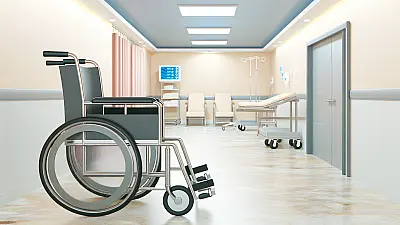HARDINSBURG, KY - Breckinridge Memorial Nursing Facility faced immediate jeopardy findings after a resident with mobility limitations left the facility unnoticed and was found trying to exit the building to the parking lot, highlighting critical gaps in resident monitoring and safety protocols.

Resident Left Facility Undetected for 25 Minutes
On April 28, 2024, a resident with diabetes, aphasia, and partial paralysis left the nursing facility on the second floor and was discovered in the hospital lobby on the first floor attempting to push open an exit door leading to the parking lot. The resident, who used a wheelchair for mobility, had navigated past staff areas, taken an elevator, and traveled through hospital corridors before being found by an acute care nurse.
Security camera footage revealed the resident left the unit at 3:58 PM and was not discovered until 4:22 PM, representing a 24-minute window where staff were unaware of the resident's location. During this time, the resident had propelled herself through the lobby and down hallways toward the radiology department before returning to attempt exiting through the main doors.
An acute care nurse found the resident "pushing on the exit door trying to get out" and stayed with her until facility staff retrieved her. The resident was found with snacks and a beverage, suggesting she had accessed food service areas during her time away from the unit.
Assessment and Monitoring Failures
Investigation revealed significant inconsistencies in the facility's risk assessments for this resident. Despite wandering risk assessments from 2022 and 2023 that indicated the resident was not independently mobile and did not exhibit exit-seeking behaviors, multiple staff members reported witnessing such behaviors in the weeks leading up to the incident.
One nursing aide reported the resident had "a lot of exit seeking behaviors in the month prior to her elopement" and had physically assaulted staff when they tried to prevent her from accessing elevators. The aide stated management was aware of these behaviors and had instructed staff to "watch [the resident] closely to prevent her from leaving the unit."
However, the facility's comprehensive care plan was not updated to reflect elopement risks until the day of the incident, after the resident had already left the facility. The facility's Assistant Director of Nursing acknowledged that nursing aides "did not have an area to chart resident checks on their flowsheets," indicating gaps in documentation systems for monitoring at-risk residents.
Medical Implications of Inadequate Monitoring
Residents with cognitive impairments, mobility limitations, and medical conditions like diabetes face significant health risks when leaving supervised care environments. Unmonitored departures can lead to medication disruptions, exposure to weather extremes, falls, disorientation, and inability to seek help during medical emergencies.
For residents with aphasia and partial paralysis, communication barriers compound these risks. Such individuals may be unable to convey their identity, medical needs, or request assistance if they become lost or experience health complications while away from the facility.
Proper elopement risk assessment protocols require ongoing evaluation of residents' cognitive status, mobility patterns, and behavioral changes. When exit-seeking behaviors are observed, facilities should implement enhanced monitoring, environmental modifications, and individualized safety interventions rather than waiting for an incident to occur.
Systemic Policy and Training Deficiencies
The investigation revealed the facility lacked comprehensive elopement policies at the time of the incident. While the facility had a "Code [NAME] Missing Patient/Resident" policy for responding to missing residents, it did not have specific protocols for elopement prevention or assessment procedures for wandering behaviors.
Staff interviews revealed inconsistent awareness of the resident's behavioral changes. While some staff reported significant exit-seeking behaviors in the weeks preceding the incident, others stated they had not witnessed or been informed of such behaviors. This communication breakdown suggests inadequate reporting systems and shift-to-shift information transfer.
The facility's monitoring relied primarily on visual observation during routine care activities, with documented care occurring at 9:02 AM and 7:59 PM on the day of the incident. The substantial gap between documented checks created opportunities for undetected departures, particularly during shift changes and lunch breaks when staffing patterns typically vary.
Additional Issues Identified
The investigation also revealed infrastructure concerns, including inconsistent door locking procedures and the absence of a ward clerk on weekends when the incident occurred. The ward clerk, who normally monitored the entrance area during weekday hours, was not present during the Sunday afternoon elopement.
The facility's security system, while capturing the incident on video, did not provide real-time monitoring capabilities that might have enabled immediate intervention. The video footage was subsequently lost due to routine recording overwrites, limiting the facility's ability to conduct comprehensive analysis for prevention planning.
Following the incident, the facility implemented immediate safety measures including placement of a monitoring device on the resident and enhanced staff education about wandering behaviors. The facility developed new elopement policies and revised assessment procedures to address the identified deficiencies.
The incident resulted in immediate jeopardy findings due to the potential for serious harm when vulnerable residents leave supervised care environments without detection or appropriate safety measures.
Full Inspection Report
The details above represent a summary of key findings. View the complete inspection report for Breckinridge Memorial Nursing Facility from 2025-01-03 including all violations, facility responses, and corrective action plans.
💬 Join the Discussion
Comments are moderated. Please keep discussions respectful and relevant to nursing home care quality.